Host Ship is situated in front of the Methven Resort and across the road from Mount Hutt College. Three structures are arranged along the site. The shelters are made of locally-sourced materials: cob, corrugated iron roofing, straw, recycled steel and timber. A wall made of earth and straw is used to support the angular roofs which connect to a down pipe. Snowsport gear can be placed into a timber frame that is attached to one of the structures. The most northern shelter is to be built by the high school students at Mt. Hutt College. This will allow students to make their own space where they can organise events or just hang out after school. During the quiet times of the year, the space could be used as meeting point for tourism or a performance space, thus making this a flexible space for the local community.
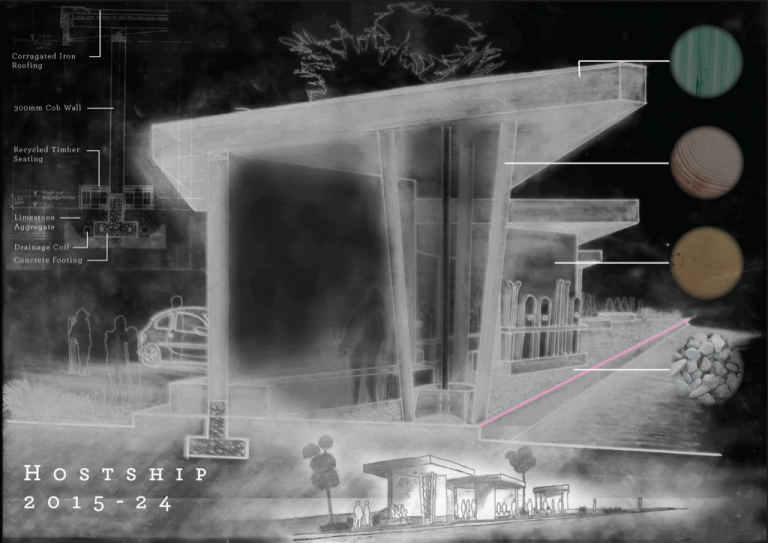
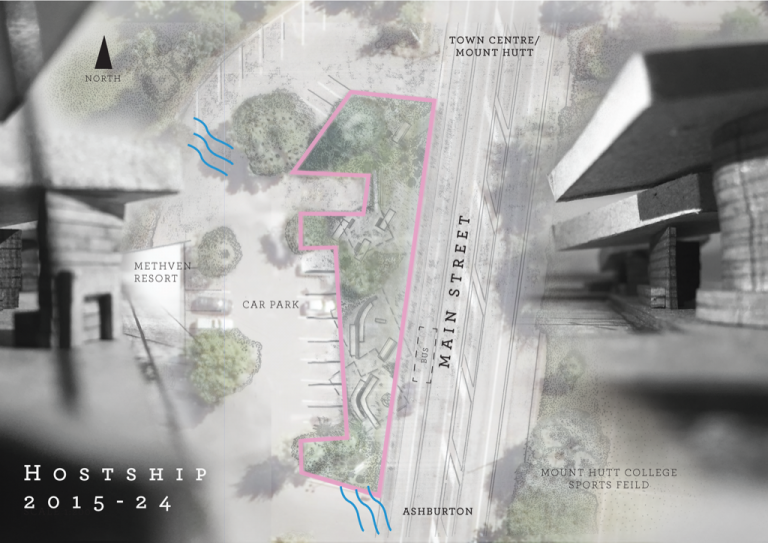
Methven Mountain Shelter is a unique semi-enclosed bus shelter that caters to travelers and to the community all year round. It acts as a shelter during the winter, a communal gathering point during summer and a historical information centre throughout the year.
The main aspect of its design is to reflect the environment surrounding the site. Consequently altering the buildings shape best suited for view of Mt Hutt, Vision for approaching buses and the weathering. The design is to be rustic, using mixture of recycled and sustainable materials. Its façade shape is to reflect the mountain ranges and Mt Hutt.
Materials included are weather boards from the Christchurch earthquake in original context as the facade to enforce historical importance of the Canterbury region. The remaining structure is made from straw bale (Non-load bearing) and timber from Douglas-fir (Load bearing) to support the recycled roofing.
This design is copyrighted by the authors under the CC-Attribution License

Rerehi Whakarutu
For our Shac bus shelter proposal we explored the concept and ideas behind curves that could be achieved using straight lines and arranging them using horizontal and vertical axis. We used this to replicate the rigorous mountain sides and combining this idea into our proposal. We wanted to achieve a shape that not only looked interesting but contrasted from the landscape that it was surrounded in. We included this idea in the roof construction of the project. The materials were sourced locally and provided a low and effective solution and helped reduce the overall carbon footprint of the bus shelter. With a combination of wooden shingles and a timber frame construction the bus shelter was primarily focused on natural materials and its conventions. We wanted to move away form the traditional bus stop design of a roof and walls to something that was unique in its own way.


Earth Circle [2015-19]
Earth Circle
Earth Circle is situated in front of Methven Resort and across the road from Mount Hutt College. Three structures are arranged in a circle, forming an open space in the centre.
The structures are made of locally-sourced materials: rocks, earth, straw, recycled timber and recycled polycarbonate sheet. Gabion blocks (wire mesh filled with rocks) form double-levelled bench seating. A cob wall (made of earth and straw) behind the benches is framed by two recycled timber posts, which support a light roof of polycarbonate and timber. Skiis and snowboards can be slotted into a timber frame that is attached to one of the structures.
The structures are simple and easy to build. This allows for the Methven community’s involvement in the construction and maintenance of the structures, making the project more broadly sustainable (not just in terms of its materiality).
The open, communal space is suitable for use throughout the year, while it is not occupied by seasonal visitors, as a market or performance space.
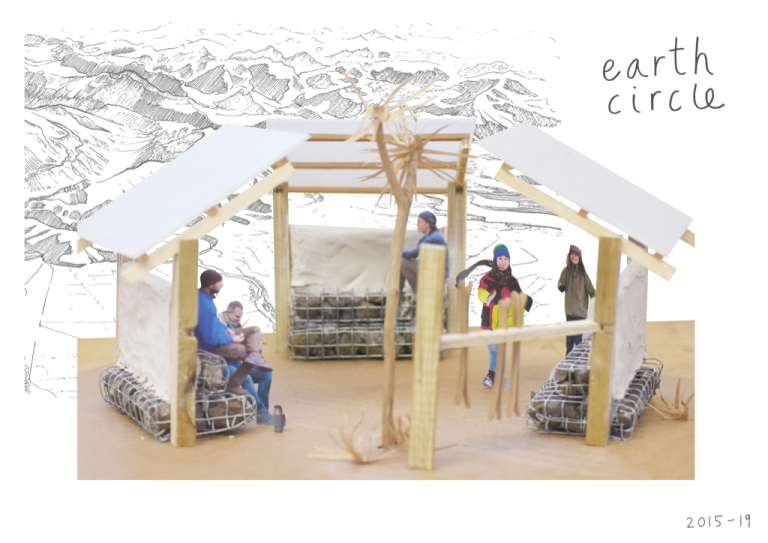

This unique and dynamic bus shelter crafted using carefully selected hearty South Island materials creates a safe haven from the Methven environment throughout the seasons. The positioning of the Shelter allows for easy circulation between the resort car park and the footpath. “Sticks & Stones” originates from the shelters solid stone central wall with protruding wooden logs which offer a number of waiting areas and gear storage benches. “Sticks & Stones” is an ideal Bus stop in winter and a playful and calming picnic and family area outside the resort in summer.

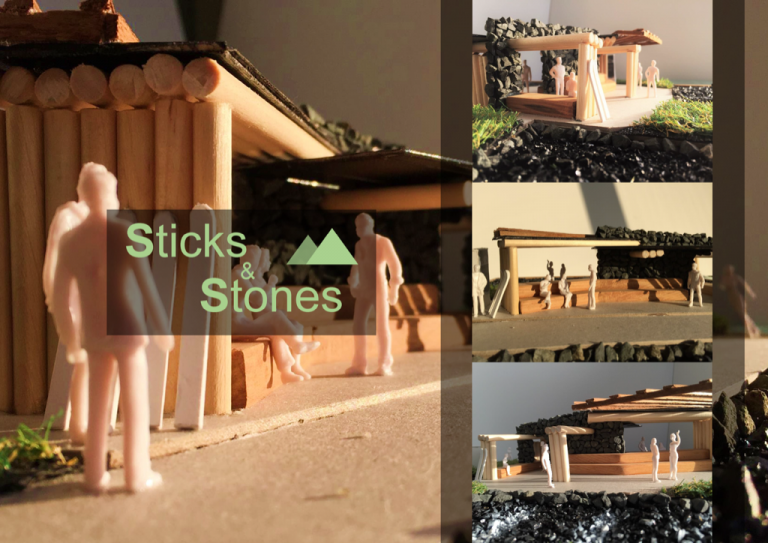
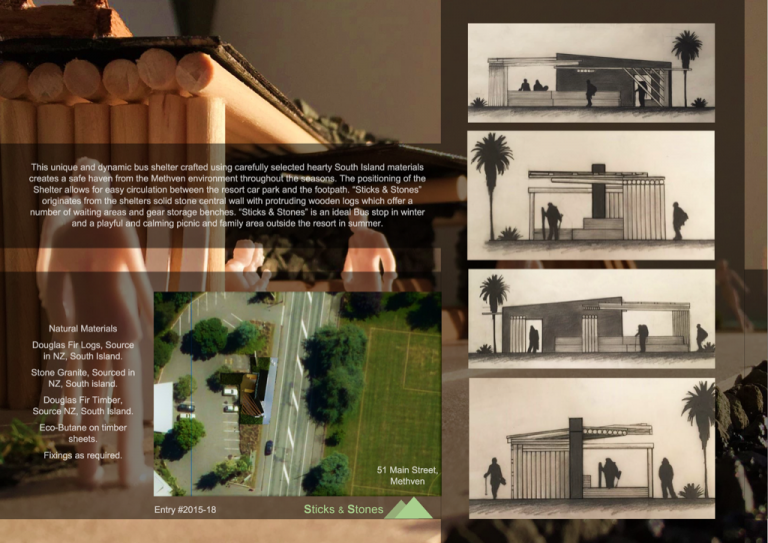
“Off the Rails” relates to the historical context of Methven. Tapping into the lines of Methven being the terminus of a historical railway system of the late 1800’s. The frame is comprised of a skeleton of recycled railway sleepers supplied locally in the Canterbury region. The walls are made up of local, recycled pallets in filled with a layer of cob, for strength and shelter. by up-cycling these materials we are transforming what was previously the end of a journey into what now facilitates the beginning of one. These materials also provide an earth and farmyard aesthetic that ties into the Methven experience. Located on Racecourse Avenue near the Ski Time Methven hotel. The shelter caters comfortably for 20 people all year round and provides a suitable shelter for all weather conditions. With its move-able barn doors and variety of seating arrangements our bus shelter will make a trip to the local mountains a social and enjoyable experience for all.


PDF (7.6MB)
MTSCAPE [2015-14]
This is a bus shelter made from natural and recycled materials designed for skiers and snow boarders in Methven, travelling to Mt. Hutt. For this reason the design is inspired by the mountain range of Mt. Hutt. The bus shelter is made from a combination of rammed earth pillars, straw bale walls and recycled corrugated iron roofing. The design is located on the site next to Methven Skitime on Racecourse Avenue.


Inspired by the beautiful mountain view of Mt. Hutt from the site, the Mountain View bus shelter allows people to enjoy the spectacular mountain scenery while waiting for the bus to arrive. The bus shelter also incorporates natural materials such as straw bale, local wood (Douglas fir), and green roofing to provide a sustainable and aesthetically pleasing shelter for both the tourists, and the local community of Methven.
Materials used are the following:
Strawbale plastered with lime for the south part of the bus shelter that functions as a load bearing wall, which withstands southwesterly prevailing winds.
Also a great natural and sustainable material that provide insulation
Untreated local (Douglas fir) wood used for the overall framing of the shelter.
Recycled glass are used for the visibility of the mountains, which also functions as a wind blocker for the North West cold wind.
Extensive green roofing for the flat roof of the shelter, which uses local small plants that could survive strong winds.
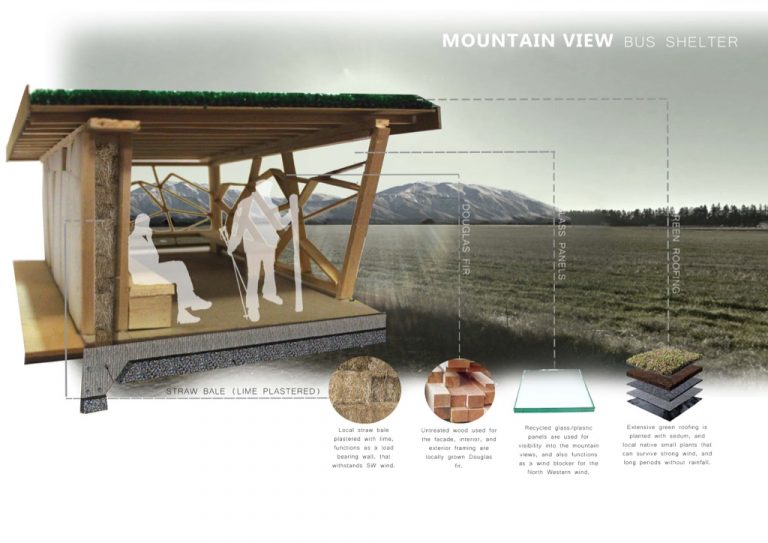
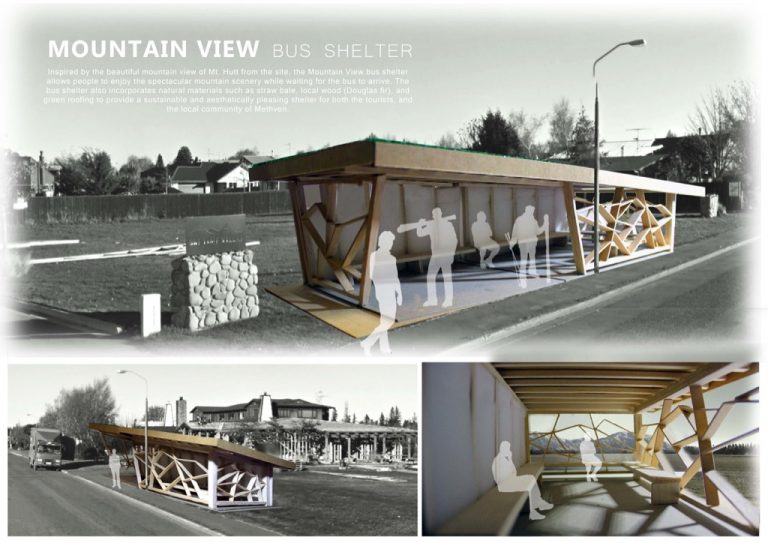
Silhouette [2015-11]
Silhouette provides a joyful social space for people to socialize. Creating sun shadows from recycled pallets.
Recycled pallet is not only used for walls and roof, but also been used as frames for construction which is resourceful, inexpensive.
Foundation is made with river stones collected from Rakaia River.
Ski gear can be stored in the gaps between pallets elegantly.
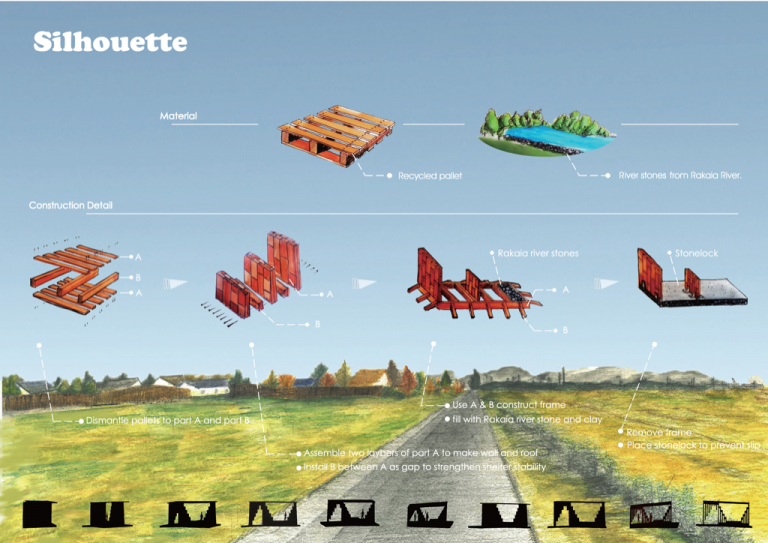
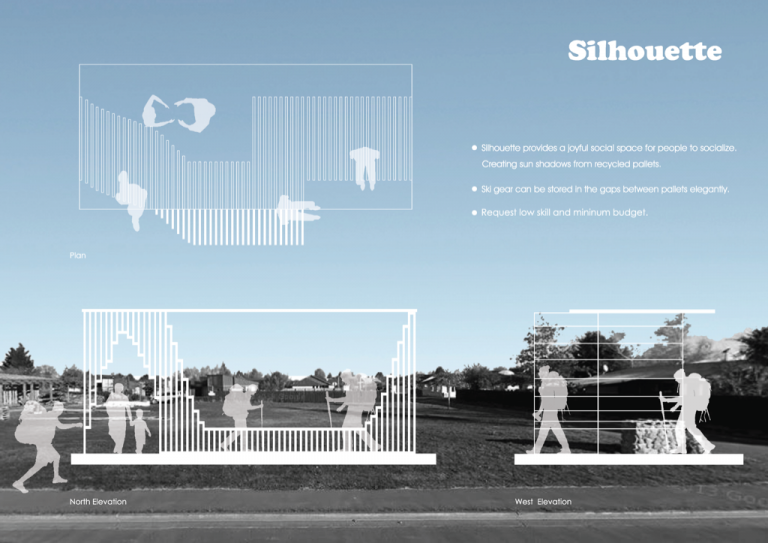
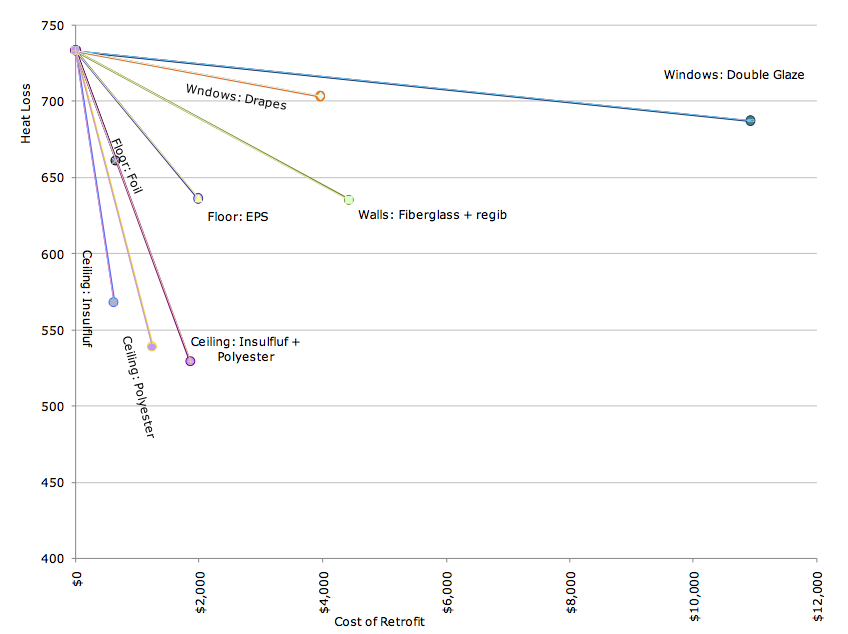
A couple common questions:
“What is thermal resistances of window film with an air gap, and curtains?”
- Timber framed window, single glazed (baseline)
- R0.2
- Timber frame, single glazed, with drapes and pelmet
- R0.3 $0-$150/m2
- Timber frame, single glazed, with window film
- R0.4 $5/m2
- Alu frame, thermal break, double glazed, low-e
- R0.4 $450/m2
- (Higher R values mean less heat loss)

“What are good retrofit options for my home”?
Reducing heat loss is one important strategy. (Another is maintaining ventilation)
Good strategies mean picking the most reduction in heat loss, for the least cost. This chart can help.

References
Bishop, T. W. (2009). Heat Losses and Gains in Residential Housing in Southern New Zealand (Thesis, Master of Science). University of Otago. Retrieved from http://hdl.handle.net/10523/354
BRANZ, ALF
